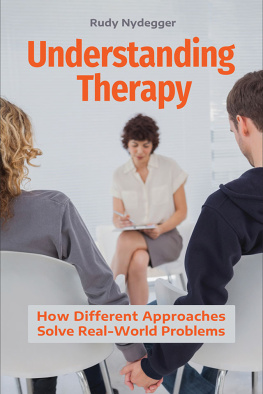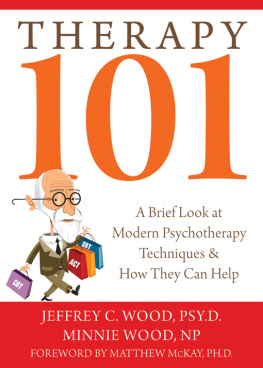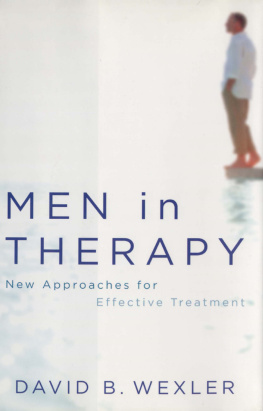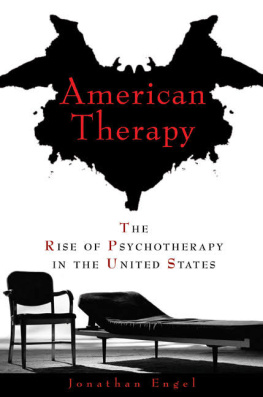A book like this depends on a lifetime of education, knowledge, and experience. There are some people whose influence in my life was certainly significant and occasionally profound. I will start with the person who had more to do with my becoming a psychologist than anyone elsethe late professor Robert Knapp from Wichita State University. I had no interest in psychology as a field and certainly was not drawn to psychology as a profession. As a chemistry and math double major who had to take a psychology course for my distribution requirements, I reluctantly signed up for introduction to psychology, and since I was in the honors program I had a small class taught by the chair of the department and found it to be somewhat interesting. I then decided to take another psychology class and signed up for experimental psychology because I wanted to see what science would be like studying people instead of physical substances in test tubes and complex equations. Professor Knapp was teaching this class, and although several students warned me that this was a difficult and boring class, I decided to take it anyway. Initially, Professor Knapp was very interested in having a student from the hard sciences sign up for his class, and as we got to know one another he was excited about my interest in the science of psychology, and he got me involved with some original research and even let me design and execute my own study. I was so excited about this that I decided that I wanted to study animals and people, and although I loved chemistry and math, I was passionate about applying science to understanding and helping people. I later got even more interested in working with people and took my scientific knowledge and approaches to working directly with and helping people using clinical psychology. Without that course and the devoted mentorship of Bob Knapp, I am quite sure I would never have become a psychologist. His friendship and wisdom were a part of my life until his recent death, and his memory is still very important to me personally and professionally.
One of the other people who had a major influence on my academic and scholarly decisions was the dean of students at Wichita State University Dr. James Rhatigan (now retired as the former vice president of student affairs). Dr. Rhatigan, who came from a counseling psychology background, was a wonderful role model who showed me how a professional person can take their knowledge, education, and training and use this background to make a positive difference in peoples lives. I have known few people who have touched more people and had a more positive influence on the lives of students, alumni, and staff of the university. Further, his impact on the values and culture of the university and higher education, in general, has been monumental.
Of course, there are many others in my background, education, and training who have had a positive impact on my professional and personal life, but these two men need to be singled out as most important in how I have spent my life and the things I have tried to do professionally.
Writing a book is a time-consuming and intense undertaking that is challenging, fun, hard work, and fulfilling. It does, however, take one away from the other things in life that one wants and needs to do. My wife Karen; my kids Ashley, Morgen, Colby, Liesl, and Austin; my grandsons Lucas and Sam; and all my other family and friends have continued to be my foundation and support and have made the effort well worth the trouble. Further, I once again must recognize and thank my editor Maxine Taylor whose support and help over the years have made me a better author, and her influence has certainly improved my books.
Thanks to all of you.
Chapter One
What Is Psychotherapy?
Originally, the term psychotherapy came from two words in ancient Greek psyche , meaning breath, spirit, or soul, and therapeia , meaning healing or medical treatment, but today it is defined as the treatment of the mind, personality, emotions, and behavior using psychological methods. The American Psychological Association adopted a resolution in 2012 that was written by John C. Norcross: Psychotherapy is the informed and intentional application of clinical methods and interpersonal stances derived from established psychological principles for assisting people to modify their behaviors, cognitions, emotions, and/or other personal characteristics in directions that the participants deem desirable.
The intention of psychotherapy is to help people make changes that they identify and agree with to improve the quality of their life. Psychotherapy is an interpersonal process that involves a psychotherapist who provides services, and (a) patient(s) or client(s) who asks for help dealing with their identified issues. What makes psychotherapy somewhat unusual as a professional service is that by listening, supporting, making suggestions, and giving advice, the psychotherapist is doing much of the same things that a persons friends or family would do to provide help. In fact, many people will avoid going into therapy because they assume that they can get the help that they need from friends or family, and therefore see no reason to have an appointment with a professional. However, there are several differences between a professional psychotherapist and a well-meaning family member or friend. First, the professional has academic and clinical training to equip them with the knowledge and skills needed to provide appropriate, meaningful, effective, and ethical treatment. Second, the professional therapist will be more objective. Third, the therapist will have no emotional connection with the patient or client, and therefore has no emotional investment in the outcome of the treatment.
There are often misconceptions about the similarity or differences between counseling and psychotherapy, and there is quite a bit of overlap between the two. Typically, counseling usually involves guidance and advice about everyday problems in specific areas and is usually of a short duration. For example, a school counselor would advise and guide students regarding academic and school-related issues, or a clergy person may counsel a member of their congregation on spiritual, moral, or ethical issues. However, it is certainly possible, that during psychotherapy there might well be some counseling used for specific issues. Some counselors (e.g., counseling psychologists) may also be trained in psychotherapy, but not all would be. Therefore, psychotherapists would be trained to provide counseling as part of their services, but not all counselors are trained to provide psychotherapy. We will discuss the various forms of treatment methods and providers in a later chapter and make it clearer as to where and with whom people should ask for and receive the psychotherapeutic help they need.
Psychology as an academic and scientific field is relatively recent (somewhat over 100 years old), and the use of psychotherapy by trained professionals is also recent by historical time. However, throughout human history there have been people who have used psychological methods to treat others for mental or even physical problems even if they did not have the professional training that we expect today. Whether it was clergy, rulers, family members, physicians, philosophers, or others, there seem to always have been members of society who others would seek out for help, advice, and support. Something resembling psychotherapy was probably first developed in the Middle East during the ninth century by the Persian physician and psychological thinker, Rhazes, who had been the chief physician at the Bagdad Psychiatric Hospital. In the West, however, the treatment of the insane was usually nonexistent, cruel, or blatantly harmful. By the 19th century in Western Europe and North America, there was a movement toward moral treatment of the insane that utilized noninvasive and non-restraint forms of treatment. Providing a comfortable place to live and sleep; having adequate nutrition, minimal if any restraint; and more humane ways of treating the mentally ill were now the more accepted ways of providing care for the insane.








